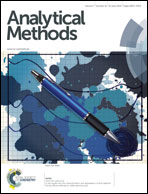Immobilization of a novel synthesized Schiff base on the surface of a gold electrode for the electrochemical study of adrenaline
Abstract
A self-assembled monolayer of 2-[({2-[(2-{[(Z)-1-(2-hydroxy phenyl) methylidene] amino} phenyl) disulfanyl] phenyl} imino) methyl] phenol was fabricated on a bare gold electrode (SITP-Au SAM electrode). The SITP-Au SAM electrode showed an obvious electrochemical activity for oxidation of adrenaline. The characterization of the SITP-Au electrode was performed by scanning electron microscopy (SEM), atomic force microscopy (AFM), cyclic voltammetry and electrochemical impedance spectroscopy in the presence of the [Fe (CN)6]3−/4− redox couple. The electroanalytical determination of adrenaline was carried out at pH 6.0 in 0.1 mol L−1 phosphate buffer solution using differential pulse voltammetry. In this way, a calibration curve was obtained in a linear range of 0.5–150.0 μmol L−1. Selective detection for adrenaline was realized by elimination of voltammetric responses for ascorbic acid and uric acid and increasing potential in the oxidation peak of dopamine on the SITP-Au SAM electrode. The detection limit for adrenaline was found to be 63.0 nmol L−1. The modified electrode showed acceptable selectivity and stability properties.


 Please wait while we load your content...
Please wait while we load your content...